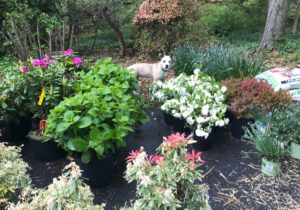Latest Posts
- Have a purpose when backyardingAugust 5 2021
- Study: Time outside alters our microbiomeAugust 4 2021
- Happy National Mutt Day from Mo-MoJuly 27 2021
- New home? Avoid these common mistakes in your yard.July 26 2021
- Infographic: Plan a backyard staycation this summerJuly 22 2021
Categories
Archive
April 20th
5 tips to celebrate Earth Day in your backyard

Earth Day is on April 22, but you can celebrate at any time in your own backyard with tips from the TurfMutt Foundation. Being a backyarder is a great way to celebrate Mother Nature. Get outside, mow your lawn, trim the bushes, and plant a butterfly bush. By becoming a steward of your yard, you are helping preserving your own corner of the overall ecosystem.
Here are five ways to celebrate Earth Day in your own backyard.
Backyard more. Thanks to your backyard, nature is just steps away. Science has proven that simply spending time in our family yards is good for our health and well-being. Researchers found that people living in neighborhoods with more birds, shrubs, and trees are less likely to suffer from depression, anxiety, and stress. Multiple studies have discovered that plants in hospital recovery rooms or views of gardens help patients heal up to one day faster than those who are in more sterile environments.
Make the outdoors a family project. Your backyard has purpose. Nearly anything you can do inside can be taken to the great outdoors of your own backyard. Take your family outside and assess your space. What’s working well with how it’s currently set up? What could be improved? What can you plan now to do together in your backyard? Is there anything that needs to be cleaned up to make space for these backyard dreams to take shape? There is no time like the present to plan, prepare and plant!
Connect your kids to nature in your backyard. Free, online, do-at-home lesson plans are available from the TurfMutt Foundation. The environmental education program resources, based on STEM (science, technology, engineering and math) principles, teach kids about the benefits of taking care of and spending time in nature. The lessons include outdoor-themed activity sheets for kids in grades K-8 that give children the prompts they need to have fun learning about and exploring the nature and science in their own backyards.
Educate yourself. There is no time like the preset to get educated about climate-zone-appropriate plants, the importance of pollinators, and how backyards can support local wildlife. The TurfMutt lessons – and the internet at large – are great resources. Once preliminary research is done, conduct a plant inventory to determine what’s currently thriving in your backyard. Match that up against the USDA Plant Hardiness Zone Map to determine the best types of turf, trees, shrubs, and plants for your climate zone.
Keep pollinators in mind. Birds, bees, butterflies, bats, and other creatures are critical to our food supply and a healthy environment. Homeowners’ yards are an important part of the connected ecosystem providing much-needed food and shelter for pollinators, so select a variety of plants that will bloom all year long. The Audubon Society’s database can help determine which birds will be attracted to which plants for unique regions so you can make good choices about what to plant.
To learn more, go to TurfMutt.com.





